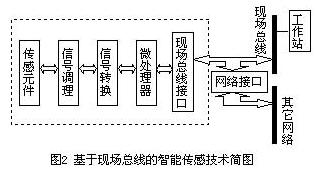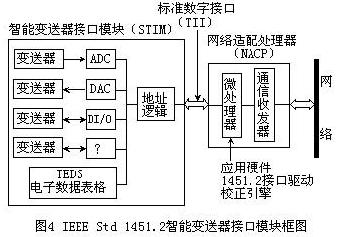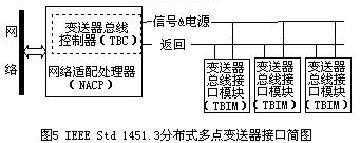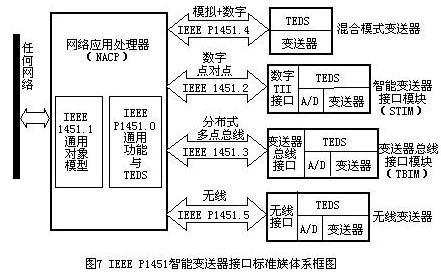1. Introduction Sensor technology, communication technology and computer technology constitute the three basics of modern information. They complete the extraction of measured information, information transmission and information processing, respectively, and are an important symbol of the development of contemporary science and technology. With the development of science and technology, digitalization, intelligence, and networking have become trends of the times: computer technology and communication technology have combined to create computer network technology; computer technology and sensor technology have combined to create smart sensor technology; One (the combination of computer network technology and intelligent sensing technology) has created a network of intelligent sensing technology. Networked intelligent sensing technology has become a hot issue. This article will briefly discuss the current status and development trend of networked intelligent sensing technology.
2. Networked intelligent sensing technology The networked intelligent sensor is based on an embedded microprocessor. It integrates a sensing unit, a signal processing unit, and a network interface unit so that the sensor can have self-checking, self-checking, self-diagnosis, and network communication functions. In order to realize the collection, processing and transmission of information, a truly unified and coordinated new smart sensor is shown in Figure 1.

Compared with other types of sensors, networked smart sensors have the following characteristics:
(1) It has a smart sensor function. With the introduction of embedded technology, integrated circuit technology and microcontrollers, the sensor becomes a combination of hardware and software. On the one hand, the power consumption of the sensor is reduced, the volume is reduced, and the anti-interference and reliability are improved. On the other hand, the sensor Self-recognition and self-calibration functions, while using software technology to achieve sensor nonlinear compensation, zero drift and temperature compensation;
(2) has a network communication function. The application of network interface technology allows the sensor to easily access the industrial control network, providing great convenience for system expansion and maintenance.
3, based on fieldbus intelligent sensing technology

Fieldbus technology is an emerging control technology that integrates computer technology, communication technology, integrated circuit technology and intelligent sensing technology. It is defined in accordance with the standards of the International Electrotechnical Commission IEC61158: "Installed in the field device and control room in the manufacturing and process area. The digital, serial, and multi-drop data busses between the automatic control devices are called fieldbuses. It is generally believed that "Fieldbus is a fully digital, two-way, multi-station communication system and a computer system industrial bus for industrial control."
Fieldbus technology is produced under the requirements of instrument intelligence and full digital control system. Fieldbus is an all-digital, open and two-way communication network that connects intelligent field devices and control rooms. With the advent of a variety of smart sensors, transmitters and actuators, a new industrial control system, the FCS (Fieldbus Control System), which digitizes the field to the field, controls the function to the field, and manages the equipment to the field, will surely Replace the traditional distributed control system DCS (DistributedControlSystem). Smart sensors based on fieldbus are shown in Figure 2.
3.1 The essential meaning of fieldbus Fieldbus is not only a communication protocol, it is not only a digital signal transmission instrument instead of the analog signal (4 ~ 20mADC) transmission instrument, the key is to replace the traditional FCS with a new generation of fieldbus control system FCS The distributed control system DCS realizes the integration of the field communication network and the control system. Its essential meaning is reflected in the following six aspects [2]:
(1) All-digital communication Unlike semi-digital DCS, the fieldbus system is a purely digital system. Fieldbus is a field digital communication network used for field automation or field automation to interconnect field devices or field instruments. Digital signals are used instead of analog signals. The transmission has strong anti-interference, high measurement accuracy, and greatly improves system performance.
(2) Field Device Interconnection Field devices or field instruments refer to sensors, transmitters, actuators, etc. These devices are interconnected by a pair of transmission lines. Transmission lines can use twisted pair, coaxial cable and optical fiber.
(3) The meaning of interoperability interoperability comes from field equipments from different manufacturers. Not only can they communicate with each other, but they can be uniformly configured to form the required control loops and realize control strategies together.
(4) The decentralized function block FCS discards the input/output unit and the control station of the DCS and distributes the function blocks of the DCS control station to the field instruments in a decentralized manner to achieve a complete decentralized control.
(5) Communication lines The commonly used transmission medium for the field bus is the twisted-pair cable. The power supply mode of the communication line allows the on-site meter to take energy directly from the communication line.
(6) Open interconnection network Fieldbus is an open interconnection network that can be interconnected with similar networks or with different networks, and can also share network databases.
3.2 Inadequacies of Fieldbus Since the birth of the fieldbus technology in the 1980s, it has received great attention from people and has been hailed as a revolution in the field of self-control. Since the 1990s, the fieldbus control system has become a hot spot for people to study and a variety of fieldbus products are emerging. With the actual application of fieldbus control system in the production field, smart sensor technology based on fieldbus also faces many problems.
On the one hand, the formulation of fieldbus international standards has resulted in the existence of multiple standards due to technical and commercial interests. IEC61158 specifies 8 kinds of field bus standards such as FF and Profibus. In addition, the three kinds of field bus international standards (ICE62026) that have been passed by IECTC17 have resulted in 12 international standards for field busses. Because the communication protocols adopted by various standards are completely different, there is a problem of compatibility and interchangeability of smart sensors, which affects the application of bus-based smart sensors.
On the other hand, fieldbus still has bottlenecks. It is manifested in: After the fieldbus is cut off, the system may have unpredictable consequences; the parameters of the system configuration are too complex, and its setting has a great influence on the system performance; the production operation requires a large amount of human-machine data exchange, field bus system The limited communication capacity can easily cause congestion in the information flow.
4. Based on the IEEE P1451 interface family of intelligent sensing technology, the IEEE P1451 family of standards is based on current fieldbus standards. Various fieldbus standards have their own defined communication protocols, which are incompatible with each other, thus giving applications to intelligent sensing technologies. Expansion and maintenance are brought forward on the basis of the adverse effects. The purpose is to greatly simplify various network control systems consisting of sensors/actuators by defining a set of general-purpose communication interfaces, to solve the compatibility problems between different networks, and to finally realize the interchange of products from various manufacturers. Sex and interoperability.
4.1 IEEE P1451 Intelligent Transmitter Interface Family Introduction The IEEE P1451 proposed family of standards defines the hardware and software interfaces of the transmitter (sensor or actuator). All of the standards in this group support the concept of a spreadsheet (TEDS), which provides the transmitter with self-identification and plug-and-play capabilities. The following is a brief introduction to the IEEE P1451 family of standards.
(1) IEEE P1451.0 [3]
IEEEP 1451.0 proposes standards, namely general-purpose functions, communication protocols, and transmitter electronic data table formats (Common Functions, Communication Protocols, and Transducer Electronic Data Sheets (TEDS) Formats). The IEEE P1451 proposed standard family consists of several standards. Although there are common features among them, there is no universal function, communication protocol, and spreadsheet format settings. This affects the interoperability between these standards. These standards are widely used in the user community. IEEEP1451.0 proposed standard is proposed to solve this problem by defining a physical layer independent of NCAP-to-transmitter module interface that includes basic command settings and communication protocols to provide common, simple standards for different physical interfaces. In order to achieve enhanced interoperability between these standards.
(2) IEEE Std 1451.1

The IEEE Std1451.1 standard, the NetworkCapableApplicationProcessor (NCAP) Information Model forsmarttransducer, was approved by the IEEE in July 1999. The standard uses an object-oriented approach to precisely define a generic smart sensor information model, covering the various applications of networked transmitters, and mapping from models to network protocols through a standard application programming interface (API). A variety of transmitters are supported using a series of functional modules such as I/O driver hardware abstraction, as shown in Figure 3.
(3) IEEE Std 1451.2

The IEEE Std 1451.2 standard, the Transmitter to Microprocessor Communication Protocols and Transducer Electronic Data Sheet (TEDS) Format, was approved by the IEEE in September 1997. The standard specifically defines the TEDS format and a 10-wire digital interface TII (Transducer Independent Interface) as well as the communication protocol between the transmitter and the microprocessor (as shown in Figure 4), so that the smart sensor / actuator module has a plug-in With the ability to use, the measurement and control network can also monitor and configure sensor/actuator channels by accessing the TEDS.
(4) IEEE Std1451.3

The IEEE Std1451.3 standard, the Digital Communication and Transducer Electronic Data Sheet (TEDS) Formats for Distributed Multidrop System, was approved by the IEEE in October 2003. The standard uses spread spectrum technology to synchronize data acquisition, communication, and powering electronic devices connected to the transmitter bus on a single signal cable. The IEEE1451.3 distributed multi-drop transmitter interface is shown in Figure 5.
(5) IEEE P1451.4

IEEEP 1451.4 proposes standard, namely Mixed-mode Communication Protocol and Transducer Electronic Data Sheet (TEDS) Formats. The IEEE 1451.1, IEEE 1451.2, and IEEE 1451.3 standards are primarily directed to digitally readable sensors and actuators with network processing capabilities. The IEEE P1451.4 standard is mainly dedicated to presenting a mixed-mode intelligent transmitter communication protocol based on an existing analog transmitter connection method. On the one hand, the mixed-mode interface supports reading and writing of TEDS on the digital interface. On the other hand, it supports analog interface pairs. Field instrument measurement; Simultaneous use of a compact TEDS for simple, low cost connections to analog sensors. The intelligent transmitter interface based on the IEEE P1451.4 mixed mode is shown in Figure 6.
(6) IEEE P1451.5
The IEEE P1451.5 proposed standard, Wireless Communication and Transducer Electronic Data Sheet (TEDS) Formats. The proposed standard was launched in June 2001 and aims to build an open standard wireless sensor interface under the existing IEEEP1451 framework to meet the needs of different fields such as industrial automation.
4.2 IEEE P1451 Smart Transmitter Interface Standard Family Architecture The IEEE P1451 standard can be divided into two parts: software-oriented interface and hardware-oriented interface. The software interface uses the object-oriented model to describe the behavior of the networked smart transmitter and defines a set of software interface specifications that enable the smart transmitter to smoothly access different monitoring and control networks. At the same time, it defines a common function, communication protocol, and electronics. Data table format to achieve enhanced interoperability between the IEEE P1451 family of standards. The software interface part is mainly composed of IEEE1451.1 and IEEEP1451.0. The hardware interface part is composed of IEEE1451.2, IEEE1451.3, IEEEP1451.4 and IEEEP1451.5, and is mainly proposed for the specific application of smart sensors. Figure 7 depicts the overall framework of the IEEE P1451 family of standards and the relationships among the various members.

It should be pointed out that although 145l.X work in concert with each other, they can also work independently from each other. 1451.1 can be used without any 1451.X hardware interface. The 1451.X hardware interface may not require the 1451.X software interface, but its software must provide corresponding functions such as sensor data or network transmission of information.
5. Conclusions The research of networked intelligent sensing technology is in the ascendant. The establishment and development of intelligent sensor interfaces suitable for industrial control systems will become the main task of the International Organization for Standardization in the coming period of time. Undoubtedly, with the establishment and perfection of the IEEE P1451 intelligent transmitter interface standard family system, the networked intelligent sensor technology defined by the IEEE P1451 standard family represents the development direction of the future measurement and control system, and will surely be more and more widely Applications.